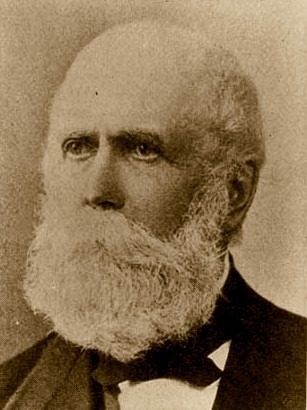Charlemagne Tower
Tower rose to business success by conventional paths. As a boy he scrupulously followed parental admonitions to work hard, avoid frivolities, and account for every penny received and spent. The grimness of youth was mellowed somewhat at Harvard, with the result that Tower ranked no better than third in the graduating class of 1830. Thereafter, a career in law led the young man to Pottsville, PA, where he became land agent for a wealthy investor in coal lands. This venture, which Tower persevered with singular perseverance, brought fortune to principal and agent alike.
By 1872 Tower began looking for a place to invest his capital and he fell under the persuasive charms of Jay Cooke. Out of the Northern Pacific (Railroad) debacle, which brought ruin to Cooke’s great banking houses in 1873, Tower salvaged large grants of western lands. In 1875 he was sufficiently liquid to respond with interest to a prospector’s report of iron deposits in northern Minnesota.
The Minnesota mining venture was pushed forward in the face of difficulties which might well have fazed a younger man. Tower, without stirring from his Philadelphia office, put together a mining enterprise of no mean dimensions. In 1884 the financial strain almost brought disaster, but the implacable Philadelphia lawyer secured a loan and his Minnesota Iron Company and its railroad, the Duluth & Iron Range, survived and grew prosperous.
But other and more powerful interests were crowding in. Faced in 1887 with the prospect of murderous competition from the Rockefeller-backed Minnesota Mining and Railroad Syndicate, Tower capitulated, sold his company for a comfortable sum, and retired. Two years later, wealthy and respected, if not famous, Tower died.”
The City of Tower was named in honor of Charlemagne Tower Sr.
Who was Jay Cooke?
Charlemagne Tower initially learned about northern Minnesota from Jay Cooke, a man from Philadelphia who “fell in love” with Duluth. Tower was knowledgeable about railroad operations and Cooke asked Tower to be on the board of directors of a railroad that he was building through the northern states of the U.S.—the Northern Pacific Railroad.
Jay Cooke was an American financier who helped finance the Union war effort during the Civil War and the postwar development of railroads in the northwestern United States. He is generally acknowledged as the first major investment banker in the United States and creator of the first broker-dealer firm. In financial services a broker-dealer is a person, company or other organization that engages in the business of trading securities for its own account or on behalf of its customers. Broker-dealers are at the heart of the securities and derivatives trading process from when he started it to today.
Charlemagne Tower and Jay Cooke were approximately the same age. Tower was born in New York, Cooke in Ohio. Both were lawyers—Tower university-educated, Cooke educated through practicing in the state of Ohio. By the time they engaged in making deals with each other, they were both residents of Philadelphia. Both men were in their early-to-mid 60’s.
Cooke arrived in Philadelphia in 1838 while Tower was living in Pottsville, PA where he practiced law and engaged in coal mining and railroad enterprises for 25 years. Tower didn’t move to Philadelphia until 1875 at the age of 68. During the Civil War, Tower raised a fighting regiment, the “Tower Guards” and after fighting in one battle left combat to chair the draft board in his area. Cooke played a significant role in the Civil War by helping to finance it.
Prior to coming to Philadelphia, Cooke had been a member of the Ohio General Assembly and then a member of the U. S. House of Representatives from Ohio from 1831 to 1833. In 1838, Cooke, age 26, went to Philadelphia where he entered the banking house of E.W. Clark & Co. as a clerk. Four years later, in 1842 he became a partner. After 16 years, he left E. W. Clark & Co. in 1858. On January 1, 1861, just months before the start of the Civil War, Cooke opened the private banking house of Jay Cooke & Company in Philadelphia.
In the early months of the Civil War, Cooke worked with Treasury Secretary Salmon P. Chase to secure loans from the leading bankers in the Northern cities. Cooke knew Chase well; he and his brother, a newspaper editor, had helped Chase get his job as U.S. Treasury Secretary by lobbying for him.
Cooke’s new firm was so successful in distributing Treasury notes that helped finance the Civil War that Chase engaged Cooke as special agent to sell the $500 million in “five-twenty” bonds – callable in five years and matured in 20 years – authorized by Congress on February 25, 1862. The U.S. Treasury had previously tried and failed to sell these bonds.
Promised a sales commission of 0.5 percent of the revenue from the first $10 million, and 0.375 percent of subsequent bonds, Cooke financed a nationwide sales campaign, appointing about 2,500 sub-agents who traveled through every northern and western state and territory, as well as the Southern states as they came under control of the Union Army.
Meanwhile, Cooke secured the support of most Northern newspapers, purchasing ads through advertising agencies, and often working directly with editors on lengthy articles about the virtues of buying government bonds. His editorials, articles, handbills, circulars, and signs most often appealed to Americans’ desire to turn a profit, while simultaneously aiding the war effort. Cooke quickly sold the $500 million in bonds, and $11 million more. Congress immediately sanctioned the excess.
Cooke influenced the establishment of national banks in 1862-1863. This was done to create a single national currency, a nationalized bank chartering system, and to raise money for the Union war effort. The Act established national banks that could issue notes which were backed by the United States Treasury and printed by the government itself. Cooke helped organize a national bank at Washington D.C., and another at Philadelphia almost as quickly as Congress could authorize the institutions’ charters.
In the early months of 1865, the U.S. Government faced pressing financial needs and the government again turned to Cooke. He sent agents into remote villages and hamlets, and even into isolated mining camps in the west, and again used ads in rural newspapers to raise more funds for the Civil War effort. Between February and July 1865, he raised money that reached a total of $830,000,000. This allowed the Union soldiers to be supplied and paid during the final months of the war.
It was in this effort that he pioneered the use of price stabilization. This practice, whereby bankers stabilize the price of a new issue, is still in use today by investment bankers in IPOs and other security issuances.
After the Civil War, Cooke became interested in the development of the northwest, and in 1870 his firm financed the construction of the Northern Pacific Railway. Cooke fell in love with Duluth, Minnesota, and decided he must make it successful, a “new Chicago”. To this end he began purchasing railways with the dream of reaching the Pacific to bring goods through Duluth into the Great Lakes shipping system and on to the markets of Europe.
Charlemagne Tower living in Pottsville, Pennsylvania, had experience in running railroads and coal mining. Because of this, Cooke asked him to be on the board of directors for his railroad, the Northern Pacific Railway. Cooke’s business was in expansion mode but it turned out that the timing was not good for that. In advancing the money for expansion of his railroad, Cooke overestimated its capital and the Panic of 1873 caused Cooke to eventually suspend operations. Cooke himself was forced into bankruptcy as well as the sale of the Northern Pacific and much of his lands in the upper Midwest.
Around this time, Charlemagne Tower had moved to Philadelphia, in 1875. With the demise of Cooke’s business, Tower and Cooke struck a business deal and Tower took over Cooke’s large tracts of Jay Cooke & Company’s land in Minnesota, North Dakota, and Washington.
By 1880, Cooke had met all his financial obligations, and through an investment in the Horn Silver Mine in Utah, again became wealthy. He died in the what is now Elkins Park, Pennsylvania, on February 16, 1905.
Places in Minnesota to Remember Jay Cooke
Jay Cooke State Park is a state park of Minnesota, protecting the lower reaches of the Saint Louis River. The park is located about 10 miles southwest of Duluth and is one of the ten most visited state parks in Minnesota.
Cooke Street is located in the Lakeside neighborhood of Duluth. A statue of Jay Cooke by Henry Shrady is located in Jay Cooke Plaza near the intersection of 9th Avenue East and Superior Street in Duluth.
This is the first in a series of articles about Charlemagne Tower that will be published over time on the Tower-Soudan Historical Society website. The series will look at various aspects of Tower’s life, the people who helped him, and how he launched the iron mining industry on the Vermilion Range.
The material for this piece comes from: “Iron Millionaire: Life of Charlemagne Tower” by Hal Bridges, University of Pennsylvania Press, 1952.
Sources:
Manipulating the World Economy: The Rise of Modern Monetary Theory & the Inevitable Fall of Classical Economics — Is there an Alternative? Martin A. Armstrong, June 28, 2021, Gatekeeper Press. ISBN 978-1-6629-1447-8.
Appletons’ Cyclopædia of American Biography, “Cooke, Eleutheros” ,1900,New York: D. Appleton.
Patriot Fires: Forging a New American Nationalism in the Civil War North, Melinda Lawson, University Press of Kansas, Lawrence, KS, 2002, p.40-64.
“When the Horn Silver Mine Crashed, historytogo.utah.gov”. Archived from the original on 2017-11-25. Retrieved 2016-04-24.
“Jay Cooke State Park”. Geographic Names Information System. United States Geological Survey. 1980-01-11“Google Maps”

